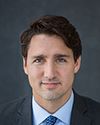Bonjour. Good morning.
I'd like to say that you've saved the best for last, just looking at the panel before you today.
Thank you very much, Mr. Chair and members.
My name is Marie-France Kenny, and I am President of the Fédération des communautés francophones et acadienne du Canada. I am here with Serge Quinty, our Director of Communications.
First, I want to thank you for inviting us to appear. We are here today on behalf of the 2.5 million francophone citizens living in the francophone and Acadian communities in nine provinces and three territories of Canada.
I would like to begin my presentation by telling you about us. The francophone and Acadian communities of Canada are descendants of the Acadians who founded Port Royal in 1604, the Métis and francophones who created the province of Manitoba in 1870, the colonists who cleared the land in northern Ontario in the early 20th century and the pioneers who founded Maillardville, British Columbia, in 1909. These are people who have lived in every province and territory for a long time.
However, the francophone and Acadian communities are also home to hundreds of thousands of francophone immigrants, individuals and families who have chosen to live in French in Halifax, Toronto and Edmonton and to contribute to our collective enrichment.
They are also Canadians whose mother tongue is English but who have chosen French out of love for the language, for those who speak it and for the opportunities it affords. I am referring, for example, to all those parents determined to have their children educated in French.
Our communities are therefore an integral part of the past, present and future of Canada, a country that we helped build and in the development of which we take part in a thousand and one ways.
It is in that perspective that we want to take part in the celebrations for Canada's 150th anniversary. This is also an opportunity to celebrate what we are and what we contribute to our country. We have a story to tell, to share. It is a vision of sharing, exchange and dialogue that we want to put forward for 2017.
You know as well as I do that Canada has changed a great deal since its centennial in 1967. And the two major principles that have transformed our country most are undoubtedly linguistic duality and multiculturalism. Our communities know something about that. They are now more than ever levers for their own development thanks to the Canadian Charter of Rights and Freedoms and the Official Languages Act.
And we are also seeing the growing diversity of Canadian society in our communities. In 2006, 13% of the population of our communities were immigrants. That is why we now talk about an open francophone community that includes all those who choose to live in French, regardless of their mother tongue or origin.
Consequently, you will not be surprised to hear that we wholly support the idea that the celebrations of Canada's 150th anniversary must include anglophone and francophone Canadians, Métis and first nations, as well as new Canadians and ethnocultural communities. We think it is important that our objective for these celebrations be to seek out and seize all opportunities to forge closer ties among all the components of what we call Canada.
Although linguistic duality and cultural diversity are widely recognized by Canadians as values that define our country and society, opportunities for dialogue and exchange among the various communities remain limited. We often get the feeling that Canadian society consists of groups that, as a result of distances or different situations, do not have the opportunity to speak to or understand one another.
When we celebrated Canada's centennial in 1967, we were not just thinking of the past, but also of the future. We must address our 150th anniversary in the same way. To consider it our objective to restore Canadians' desire to know one another and to move forward as a collective "we" is to secure our country's future in a century in which an aggregate of minorities will become the new majority. It is to show the entire world how we can achieve unity in diversity. To be able to say that, in 2017, all components of Canadian society have taken the time to know each other, to speak to each other, to recognize each other as fellow citizens, while respecting each other's specificity, is not only desirable, but also infinitely useful in developing a country such as ours.
For us, the francophone and Acadian communities, that would mean that we would finally stop seeing ourselves solely as minorities and view ourselves instead as citizens. It would also mean that we would understand, once and for all, that francophones and anglophones have equal linguistic rights and that that equality benefits Canada as a whole.
We would be very much in favour of the Government of Canada playing a leadership role on the occasion of Canada's 150th anniversary and supporting activities that create opportunities for dialogue among the various components of Canadian society. The FCFA is prepared to cooperate in the creation of those opportunities for dialogue. We have ideas, key concepts to present to you for that purpose.
First of all, since we are talking about the future, we believe it is essential to focus on activities that encourage dialogue and exchange among young people. Our communities have many success stories in this area. I am thinking of the many editions of the Jeux de la francophonie canadienne. I know how many young people have taken part in them, who have enjoyed that intense experience with other young francophones and have emerged from it motivated and proud to be francophone. I am thinking of the Parlement jeunesse pancanadien, organized annually by the Fédération de la jeunesse canadienne-française with young people across the country. These activities have had remarkable success and could serve as models for broader initiatives that would bring together young people from the various components of Canadian society.
It is also important that exchange and dialogue initiatives not be launched merely at the national level. They should involve people in all regions of the country and at the local level, where the Canadian experience is more vibrant and original. With regard to these exchanges, which may occur between schools and organizations operating in a single sector or groups of citizens, we believe we should focus not on an outdated vision of the other group, but rather on its assets and knowledge, on who we are today. We believe that tourism, culture, heritage and economic development are promising areas.
Lastly, since we are talking about the importance of a common understanding of who we are, we cannot overlook the fact that, in Canada, perspectives on the history of our society vary from region to region, from community to community. Major events, such as Champlain's arrival in Port Royal, in Quebec City, contact with the first nations, the arrival of British colonists in the 18th century, the opening of the Canadian west and the establishment of the first settlements in the Arctic, are told differently by English Canadians, Quebeckers, the francophone and Acadian communities and the first nations. We think that Canada's 150th anniversary would be a good opportunity to develop a history textbook that brings together many perspectives, that could be offered in the schools across the country. That textbook would be drafted by a committee including experts from the various components of Canadian society.
Of course, as suggested for the Vancouver Olympic and Paralympic Games, it is essential that Canada's linguistic duality be a prominent factor in all 150th anniversary activities supported by the federal government. That means, in particular, including language clauses in all transfer agreements with the provinces and territories for events as part of those celebrations. It also means that the ceremonies at all events funded by the Government of Canada will take place in both official languages.
Lastly, in light of the challenges we faced with signage at the Richmond Olympic oval, it is important that measures be taken to ensure that the entire physical legacy of the 150th anniversary has signage in both official languages.
I will conclude by making a specific recommendation to this committee for the purpose of the report it will be preparing at the end of this study. You have heard a broad variety of ideas and visions from various stakeholders. There is clearly a desire for Canada's 150th anniversary to be celebrated extensively, inclusively and in a positive and unifying manner, leaving a tangible legacy behind it. Now we need clear leadership to ensure all that becomes a reality.
There is still no central coordination to establish a clear vision of the 150th anniversary. And yet 2017 is only five years away. That is why we recommend establishing a committee that would be responsible for coordinating preparations for the 150th anniversary celebrations for the Government of Canada in partnership with the provincial and territorial governments and Canadian civil society. That committee should be inclusive and, in particular, include representatives of the francophone communities outside Quebec. When the Hon. James Moore, Minister of Canadian Heritage and Official Languages, appeared before you, the discussion turned to consultations and round tables with the first nations to determine how they wanted to celebrate Canada's 150th anniversary. We consider that idea very appropriate, but it is also important that such consultations also be conducted with the official language minority communities.
I'd like to thank you, and I will be happy to answer any questions in either official language.
Thank you.








